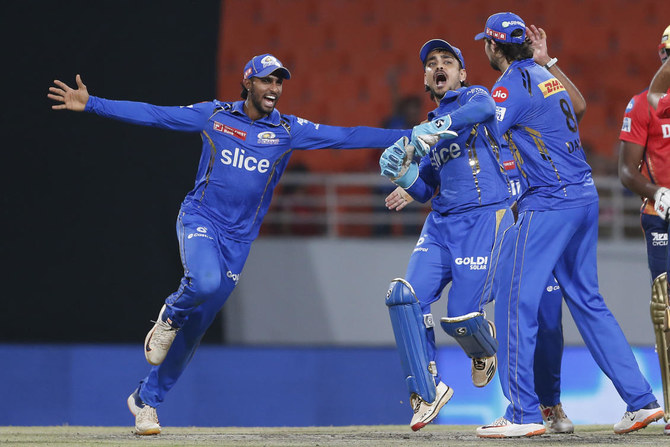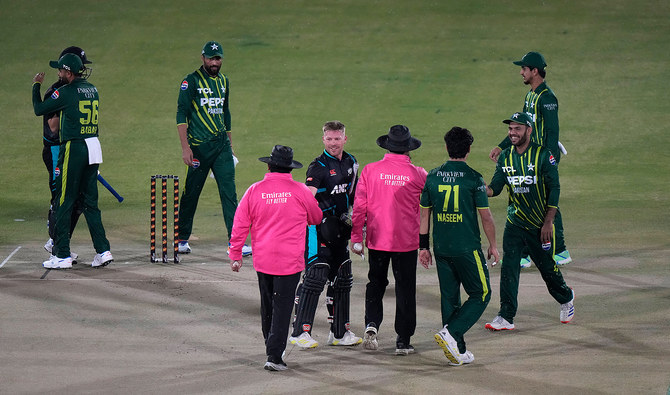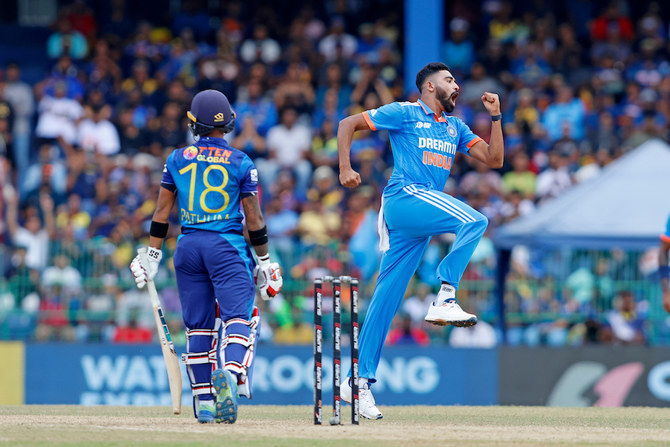ISLAMABAD: The Pakistan Super League is not like any other Twenty20 cricket competition. It can’t compete financially with the lucrative Indian Premier League in terms of player payments, yet it’s a dream for some cricketers just to be playing in it.
For the Pakistan Cricket Board, it’s considered a pathway to resuming fully-fledged international cricket on home soil.
It has been nearly a decade since a terrorist attack on the Sri Lanka team bus at Lahore in 2009 resulted in the suspension of international cricket in Pakistan, forcing the national team to play its ‘home’ games in the United Arab Emirates.
Pakistan cricket organizers also had no other option when launching their flagship T20 tournament in 2016 but to organize the entire first edition in the UAE.
But that started a step-by-step process to bring international cricket back to Pakistan, a country of more than 200 million and where cricket is the major sport. The 2017 PSL final was staged in Lahore, demonstrating that local security agencies could safeguard foreign players.
Last year, Lahore hosted two PSL playoff games before the final was held in Karachi, Pakistan’s largest city.
The 2019 edition, which starts in the UAE on Thursday, will feature eight games in either Lahore or Karachi involving all six franchises later in the tournament.
Pakistan Cricket Board chairman Ehsan Mani wants even more in 2020, telling The Associated Press, “I’d I like to see majority of the matches next year to be held in Pakistan.”
Lahore and Karachi have been focal points of the push for more cricket on home soil, hosting Twenty20 games against a World XI, Sri Lanka and the West Indies. But progress is being held back by the lack of improvements to stadiums in cities such as Rawalpindi, Multan and Faisalabad.
“We have certain limiting factors,” Mani said. “We need the other stadiums if we’re going to bring all the matches back to Pakistan.”
Mani took Pakistan cricket’s top job soon after cricketer-turned politician Imran Khan, who is also the PCB patron, was sworn in as prime minister last year. Mani is now looking to Khan’s government for funding to “help us bring these stadiums up to scratch.”
Mani said the league was watched by more than 100 million people last year and its sponsorship and broadcast rights deals continued to grow rapidly despite Pakistan’s economic situation.
“PSL is unique,” he said. “It’s an enormous market, and the best endorsement that PSL had is our commercial partners.”
West Indies star Darren Sammy, who plays for Peshawar Zalmi, has become a household name in Pakistan after winning the 2017 final at Lahore and reaching the final in Karachi last year.
This year, South Africa’s A.B. de Villiers will be representing Lahore Qalandars and has already promised to showcase his batting prowess at Qaddafi Stadium next month.
“There’s no doubt there’s a lot of goodwill now for Pakistan around the world,” Mani said. “There’s also no doubt that as more and more players come and play in the PSL, the level of confidence in the ability of Pakistan ... to organize matches in a secure and safe environment has increased.”
Mani is hopeful that another incident-free PSL will encourage Bangladesh and Sri Lanka to return to Pakistan for full international series later in the year.
“We’ll be engaging with them earlier rather than later to make sure that they have the comfort and security that they require to be able to come and play in Pakistan,” he said.
Mani couldn’t convince Cricket Australia to play at least two one-day internationals in Pakistan next month, with a five-match series instead going ahead in the UAE, but he said the Australians were committed to sending their security experts to the PSL to assess the situation.
“The perceptions of Pakistan will change,” Mani said, “We’ve got no doubt about it.”
An International Cricket Council taskforce was behind the World XI’s tour in 2017 which included South Africa’s Faf du Plessis and current Australia test captain Tim Paine, but the sport’s world governing body can’t insist on foreign teams returning to Pakistan.
“There’s no doubt that ICC is comfortable to let its match officials come to Pakistan, to let its umpires and referees and others come here,” Mani said. “That’s a big endorsement on how Pakistan is going.”
Wasim Khan, the PCB’s new managing director, believes it won’t be long before Pakistan is hosting test matches again.
“Pakistan is now ready ... it’s starved of international cricket,” Khan said. “We need the youngsters to see our heroes playing here, not in the UAE or other part of the world.”
Others, such as former Pakistan captain and now television analyst Ramiz Raja, suggest the PSL could create a feel-good factor among foreign players.
“The PSL is a great vehicle to further the case and is creating positive vibes about the country,” Raja told The AP. “The foreign players have not only acted as ambassadors but are successfully pleading Pakistan’s case to the world.”
Respected cricket analyst Abdul Majid Bhatti said about 40 foreign players will be competing in PSL, and at least 30 are committed to traveling to Pakistan for the latter stages.
But Bhatti, who works for leading Urdu language newspaper Daily Jang and at Geo TV, said the status quo wouldn’t change until the major cricket countries such as India, England, South Africa and Australia starting touring Pakistan.
“Unless foreign teams play test matches in Pakistan, revival of international cricket looks difficult,” he said, “but it’s not impossible.”
Fans in Pakistan see the PSL as an ideal platform for bigger things.
Foreigners “think Pakistan is a terrorist country, this is not like that,” Karachi-based Tayyaba Aleem said. “There was lot of security here before and it’s even beefed up more. So those who do not come, they should come.”
PSL: A pathway to revive international cricket in Pakistan
PSL: A pathway to revive international cricket in Pakistan

- We want all PSL matches coming back to Pakistan: PCB Chairman
- PCB failed to convince Cricket Australia to play at least two one-day internationals in Pakistan
Mumbai Indians survive Ashutosh Sharma scare to beat Punjab Kings

- Suryakumar Yadav hit an impressive 78 runs off 53 balls to help Mumbai Indians post a solid 192-7
- Sharma hit an explosive 61 runs off 28 balls for the Punjab Kings, but it was not enough to carry the day
Invited to bat first, Mumbai Indians started off on a decent note. After losing only two wickets in the first 12 overs, Suryakumar Yadav went on to smash an impressive 78 runs off 53 balls to help the team post a solid 192-7.
The second innings began on a disastrous note for the Punjab Kings, with fast bowler Gerald Coetzee and Indian pacer Japsrit Bumrah striking quick to leave them reeling at 14-3 at the end of the second over.
Sharma eventually managed to help rebuild the innings with an explosive 61 runs off 28 balls, aided ably by Shashank Singh (41) and Harpreet Brar (21), but it was ultimately not enough to carry them through the day.
Punjab Kings acting captain Sam Curran said it was “heart-breaking” for his team to take it close and still lose.
“This team loves a close game. Got well to get close, thanks to Ashutosh... Hopefully we can win the close ones and get the momentum,” Curran added.
Mumbai openers Ishan Kishan and Rohit Sharma kicked off the first innings with an 18 run partnership before Kishan, who hit eight runs off eight balls, fell in the third over leaving the team at 18-1.
Sharma, who scored a 25-ball 36, built another partnership with Suryakumar Yadav before falling in the 12th over. Yadav went on to smash 78 runs off 53 balls before being dismissed in the 17th over.
Young Tilak Varma went on to rack up a solid 18-ball 34, with the assistance of cameos from Hardik Pandya (10) and Tim David (14), to help Mumbai wrap up the first innings at 192-7.
The game seemed in the bag in the early portion of the second innings, partly due to sharp bowling by Coetzee and Bumrah, who took three wickets each.
When the glimmer of hope given by Sharma was extinguished, Kagiso Rabada put up a last-ditch attempt with eight runs off three balls but ultimately ended up falling in the last over.
“What a game. We started really well. Cricket’s a funny game. We thought we had it, they battled really well. Then it was like a see-saw,” said Coetzee.
Li and Hend one back of Catlin while Moroccans Lguirati and Raouzi make cut at 2024 Saudi Open

- John Catlin birdied the 18th to remain at the top of the 2024 Saudi Open presented by PIF leaderboard
- Moroccans Ayoub Lgiurati and Othman Raouzi made the cut as Saudi amateur Khalid Walid Attieh missed by one stroke
RIYADH: Li Haotong and Scott Hend made the most of the calm morning conditions to head into the weekend one shot behind pacesetter John Catlin, who leads on 10-under-par after day two of the 2024 Saudi Open presented by PIF.
Catlin birdied the 18th hole as the sun set on a warm day at Riyadh Golf Club to ensure he heads into Friday ahead of Chinese star and DP World Tour member Li, who shot a scintillating 65, and Australian Hend. Steve Lewton’s 64 was the best round of the day and sees him in third place alongside David Puig, who finished his round with a triple bogey on the ninth hole.
Amateur Khalid Walid Attieh looked set to make history as the first Saudi player to make the cut since the tournament was elevated to the Asian Tour, however three bogeys on the back nine saw him miss out by one, with a putt just sliding by at the last.
Moroccan golfers Ayoub Lguirati and Othman Raouzi, who were two of the golfers given special invites to the tournament as part of Golf Saudi’s strategic partnership with the Arab Golf Federation, finished on one-under-par and even par respectively to extend their participation.
Lguirati said: “It was a positive day for me with only one bogey and one birdie. I stuck to my strategy all day and ended with a good result in a tough competition. I am very happy to have made the cut in this tournament and to play over the next two days.
“I usually play on the second tier Asian Development Tour but with the help of the Royal Moroccan Golf Association and Golf Saudi I have been able to reach this level and I continue improving.”
Meanwhile, Li is excited to challenge for the 2024 Saudi Open presented by PIF trophy as he looks to put some recent poor form behind him. Four birdies in five holes on his back nine catapulted him up the leaderboard.
Li said: “I played really well and wasted some chances. The course played a lot easier compared to yesterday, because of no wind and easier pin positions.
“I am still struggling a little bit off the tee, but except for that everything’s pretty solid overall. I am here to try and get the job done and get the trophy! So hopefully I have a hot start tomorrow.”
Li will play alongside Hend and Catlin on Friday, but will be wary of Asian Tour Order of Merit leader Puig in the penultimate group, who won the PIF Moment of the Day for a stunning front nine of 29, which included five birdies and an eagle in his first six holes.
Rain wipes out first Pakistan-New Zealand T20 after just two balls

- Fast bowler Mohammad Amir returned to international cricket after nearly four years
- Having come out of retirement last month, Amir’s participation was limited to just fielding
RAWALPINDI: Heavy rain caused the first Twenty20 international between Pakistan and New Zealand to be abandoned after just two deliveries in Rawalpindi on Thursday.
New Zealand skipper Michael Bracewell won the toss, which had also been delayed by 30 minutes, and opted to bat but no action was possible for two-and-a-half hours.
Umpires Ahsan Raza and Aleem Dar then announced a five-over-a-side game at 10:10 local time (9:10 GMT).
Pakistan paceman Shaheen Shah Afridi conceded two leg-byes to debutant Tim Robinson off the first ball before bowling the batsman with a sharp delivery off the next.
But as soon as the Pakistan fielders started celebrating the wicket, the rain returned to force an abandonment.
Fast bowler Mohammad Amir returned to international cricket after nearly four years, having come out of retirement last month, but his participation was limited to just fielding.
The 32-year-old retired in December 2020 after being dropped from the side but changed his mind last month and decided to restart his career, which had already been stalled by a match-fixing ban in 2010.
Pakistan handed T20I caps to batsman Usman Khan, spinner Abrar Ahmed and all-rounder Muhammad Irfan Khan, while Robinson debuted for New Zealand.
The remaining matches are in Rawalpindi on April 20 and 21 and in Lahore on April 25 and 27.
The series gives a chance to both teams to test their bench strength ahead of the Twenty20 World Cup to be held in June in the United States and the West Indies.
New Zealand are without nine key players, including skipper Kane Williamson, who are playing in the ongoing Indian Premier League.
Juventus ordered to pay Ronaldo $10.4 million in back salary

- The five-time Ballon d’Or winner was the world’s highest-paid sportsman in 2023, with $136 million, including $46 million in wages
Rome: Juventus must pay Portuguese star Cristiano Ronaldo 9.7 million euros ($10.4 million) in back wages for the 2020-21 season, the Italian courts announced on Wednesday.
The Court of Arbitration, to which Ronaldo appealed, “orders Juventus Turin to pay the sum of 9,774,166.66 euros,” plus interest and procedural costs, it stated in its decision.
The sum equates to the difference between the salary actually received by Ronaldo and that which he should have received after tax and other deductions.
Ronaldo, who spent three seasons in Italy with Juventus (2018-21) before joining Manchester United (2021-22) and then the Saudi club Al Nassr, was claiming 19.5 million euros but the arbitration panel reduced that by 50 percent.
Contacted by AFP, Juventus declined to comment, but said it would be issuing a statement “shortly.”
According to the rankings drawn up by the American business magazine Forbes, the five-time Ballon d’Or winner was the world’s highest-paid sportsman in 2023, with $136 million, including $46 million in wages.
Juventus, who are listed on the stock exchange, recorded losses of 123.7 million euros in the 2022-23 financial year, which ran to the end of June, it announced in October.
No provision has been made in the accounts of Italian football’s most successful club, currently third in Serie A, for the payment of this wages backlog.
Marketing as much behind expansion of Asia Cup as merit

- Non-cricket fans may struggle to comprehend the links between the Asia Challenger Cup, the Asia Premier League and the Asia Cup
MUSCAT: Even to cricket aficionados — sometimes referred to as badgers — the various ways teams can qualify for the world’s major tournaments might appear opaque.
As may the term “badger”. Badgers are known for their tenacity, focus and persistence, qualities which can apply to those who dedicate chunks of their life to the game, its history, statistics, spectating, discussion and administration. This is not a complete list, but it provides a flavor.
A test case for tournament opaqueness is the Asia Cup. Non-badgers can be forgiven if they fail to comprehend the links between the Asia Challenger Cup, the Asia Premier League and the Asia Cup. They all fall under the aegis of the Asia Cricket Council and their existence represents an attempt by the organization to provide a more coherent regime for qualification into the big event — without using the word “qualification.”
The situation was much simpler in 1983, when the ACC was founded with the aim of promoting goodwill between Asian countries. In 1984, the first edition of the Asia Cup was held in Sharjah, where the ACC was based. It was One Day International in format and India won, but then boycotted the 1986 event because of strained relations with Sri Lanka. Strained political relations with India caused Pakistan to boycott it in 1991 event, whilst the 1993 cup was cancelled for the same reasons. Sadly, the ACC’s original aim was sorely tested almost from the outset.
Subsequent tournaments did not fit any regular temporal pattern. It was not until 2009 that the tournament was regularized onto a biennial basis. In 2015, the ACC announced the tournament would be played on rotation between ODI and Twenty20 International formats. Despite the introduction of a group stage to allow a slight expansion in the number of teams, the tournament has normally had only six competitors.
The International Cricket Council’s decision in April 2018 to grant T20I status to all 104 member nations – both men’s and women’s teams - has had far-reaching effects on cricket, including the Asia Cup. The number of countries with teams playing formalized T20 cricket at international level has grown rapidly.
It could be argued that the decision democratized cricket for both men and women. The 50-over ODI format requires a longer commitment and a deeper allocation of resources beyond the means of many of the boards administering cricket. T20 cricket offered a quicker, less resource-intensive route for the teams of associate member countries to test themselves not only amongst their peers, but also against the full members on the pitch. It has become a format for the many, not the few.
However, there remains a huge gulf between funds available to associate members and full members. This situation is exacerbated by the ICC’s decision-making regime which allows very little representation for associates. In the latest, 161st edition of the Wisden Almanack, its editor berates last year’s decision to increase the Board of Control for Cricket in India’s share of ICC’s central funds from 25 to 38.5 percent. It is not as if it needs the funds.
The BCCI argues that, since it brings the lion’s share of revenue into the game, it should be proportionately rewarded. This argument suggests a desire to control other members rather than encourage their development. Wisden’s editor asks: “Is it really beyond the wit of the administrators to distribute cash according to need, not greed?” By way of example, the West Indies cricket board receives just under 5 percent of ICC central funds. No wonder its premier players frequent the game’s franchise leagues.
The views of Wisden’s editor will probably be regarded in cricket’s power circles as a rage against the dying of the light for a previous regime, governed from England. Whilst it is true that regime was as concerned with its own protection as the current one, its idea of spreading the game was somewhat parochial. It is in that context that the ICC’s mission to spread the game should be seen. Now, cricket is not only played internationally in countries which raise the eyebrows of many when the name is mentioned, it is also accompanied by grass roots growth.
Given the recognized closeness between the ICC and the BCCI, whose secretary is also president of the ACC, the motives for restructuring the Asia Cup are worth exploring. If it is accepted that T20I cricket has the potential to provide a more level playing field, at least in terms of recognition of performance to a global standard, then the competitive structures should encourage meritocracy. This does lead to criticism that the breaking of records by associate players dilutes those set by full member players. There was such an example in Oman this week when Nepal’s Dipendra Singh Airee hit six sixes in an over, no mean feat in any standard of cricket.
This achievement will have set off the cricket badgers. One remarkable coincidence is that the umpire at the bowler’s end had also stood on another occasion when six sixes had been struck in an over. The badgers should also reflect on the possibility that the Asia Cup structure made this possible. At the base of the three-tier structure is the Asia Challenger Cup, from which two teams progress to the second tier, the Premier Cup. The winner of that is elevated to the Asia Cup with the full members. The pathway provides every ACC member with a chance to strive for this nirvana.
Yet the structure is not just about merit, it is also about commercial opportunity. Three stand-alone competitions offer the opportunity, it is argued, for each to be marketed separately, thus increasing their commercial potential. The most visible sponsorship at both the Challenger and Premier Cups has been by DafaNews and 1XBet, plus FanCode. This is sponsorship of a highly specific, and in some eyes potentially contentious, nature. Badgers may need to be tenacious in rooting out the relationship between the new Asia Cup structure and its sponsors.















